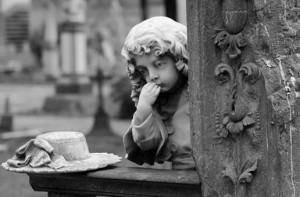The cult of the dead and visits to cemeteries became a habit common in the West in the second half of the 19th century. This new practice was facilitated by an arguably side, they believed the cult of the dead an element of civic-mindedness, the other by Catholics, that contrasts with what until previous century, experienced during visits to the cemetery a "rapprochement", a kind of meeting with their deceased loved ones.
In the 19th century was created the form of funeral rite is closest to what we know today: the introduction of rigid patterns of rites and rituals allowed him to accept the idea of death and create a sort of living with it, thus breaking the silence between the living and the dead which existed for centuries and exorcising the fear of death.
Demonstrating the demonization of death, Tomb architecture was modified: the graveyards as we know them today, just outside the city walls, were built in the 19th century, After the issuance of the edict of Saint Cloud (1804). l cemeteries had increasingly large and monumental spaces, rich of statues and buildings. Families began to visit graveyards together, and it is not uncommon for the monumental tombs were just the nuclear family as the main subject of the sculpture.
Another fundamental aspect that was created in the 19th century is the combination of death and female, that is the so-called death-female. This was identified with the "Angel woman", the one that accompanied the "good death" or dying herself for consumption; on the other, Instead, identified with the "femme fatale", the woman who did die, often for shameful diseases as syphilis.
The participation of women to death and burial has very ancient origins, but in the 19th century (and in some areas in Italy until the second half of the 20th century) It was very common figure of professional mourning, or the woman who was paid to cry and complain during the funeral of a stranger.
The omnipresence of the female figure reveals the bond between, more strongly than ever, Eros and Thanatos, the impulse to life and death: the nineteenth century was a century of transition with regard to the processing of death, and despite the "repression" by the Church, many rituals sprung or readapted in that time have survived until today.
Maria
